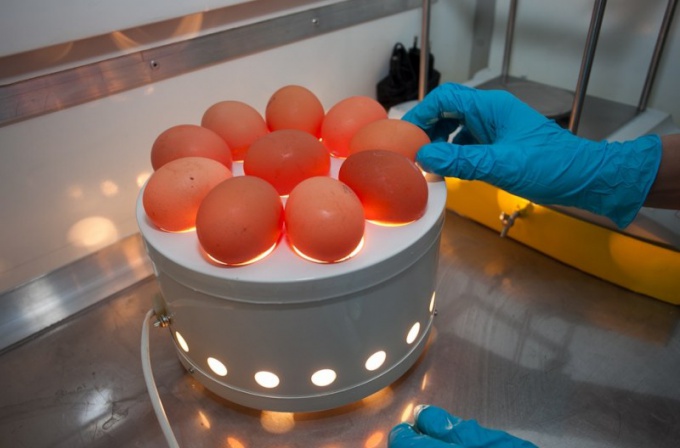To determine the quality of eggs and determine whether they are developing the embryo, there is a device candling. It is easy to use and its design is so simple that some craftsmen produce analogues of this device in his own home.
In this device there is a hole to which to attach eggs. Thus they are x-raying and found out whether there is a fetus. Before beginning the procedure it is recommended to thoroughly wash hands or wear thin rubber gloves. Note that lowering the temperature of eggs in the early stages of embryo development is fraught in his death. Therefore, in the room where an inspection is carried out by candling, it should be warm.
The whole procedure needs to occur quickly. Optimally, if you will attend an assistant who will serve eggs and put them after the x-raying in the incubator or nest. Checking eggs for the presence of the embryo should be carried out not earlier than 5-6 days after hatching. Until that time it will not give any results.
If the radiographic inspection showed that under the shell there is a clearly visible dark spot or area of yolk streaked with thin blood vessels, then the egg is life. The embryo is visible particularly well in case if it is located close to the shell. His lack of immersion in the yolk suggests that the development of the chicken leaves something to be desired.
If no candling, and there is an old projector of slides, you can check with him. This egg is applied to the hole from which the light beam is supplied, and determines whether it is an embryo. Similar, but less comfortable way – using bright light bulbs (for example, 150 W). To avoid glare, you can do so: roll in a tube sheet of A4 paper and it one side to make the egg, which must be carefully adapted to the light source.
There is another interesting way to check whether there was fertilization. 3-4 days before the end of the hatching eggs need to atone. Each of them is alternately dipped into a bowl with a small amount of warm water and watch the behavior of the liquid. From the egg in which the fetus develops, the water going in circles, resembling those that come from the float when fishing. If fertilization did not occur or the embryo died, the water remains stationary.
How to Voskobitova?
In this device there is a hole to which to attach eggs. Thus they are x-raying and found out whether there is a fetus. Before beginning the procedure it is recommended to thoroughly wash hands or wear thin rubber gloves. Note that lowering the temperature of eggs in the early stages of embryo development is fraught in his death. Therefore, in the room where an inspection is carried out by candling, it should be warm.
The whole procedure needs to occur quickly. Optimally, if you will attend an assistant who will serve eggs and put them after the x-raying in the incubator or nest. Checking eggs for the presence of the embryo should be carried out not earlier than 5-6 days after hatching. Until that time it will not give any results.
If the radiographic inspection showed that under the shell there is a clearly visible dark spot or area of yolk streaked with thin blood vessels, then the egg is life. The embryo is visible particularly well in case if it is located close to the shell. His lack of immersion in the yolk suggests that the development of the chicken leaves something to be desired.
Folk methods for determining oplodotvorennogo eggs
If no candling, and there is an old projector of slides, you can check with him. This egg is applied to the hole from which the light beam is supplied, and determines whether it is an embryo. Similar, but less comfortable way – using bright light bulbs (for example, 150 W). To avoid glare, you can do so: roll in a tube sheet of A4 paper and it one side to make the egg, which must be carefully adapted to the light source.
There is another interesting way to check whether there was fertilization. 3-4 days before the end of the hatching eggs need to atone. Each of them is alternately dipped into a bowl with a small amount of warm water and watch the behavior of the liquid. From the egg in which the fetus develops, the water going in circles, resembling those that come from the float when fishing. If fertilization did not occur or the embryo died, the water remains stationary.



